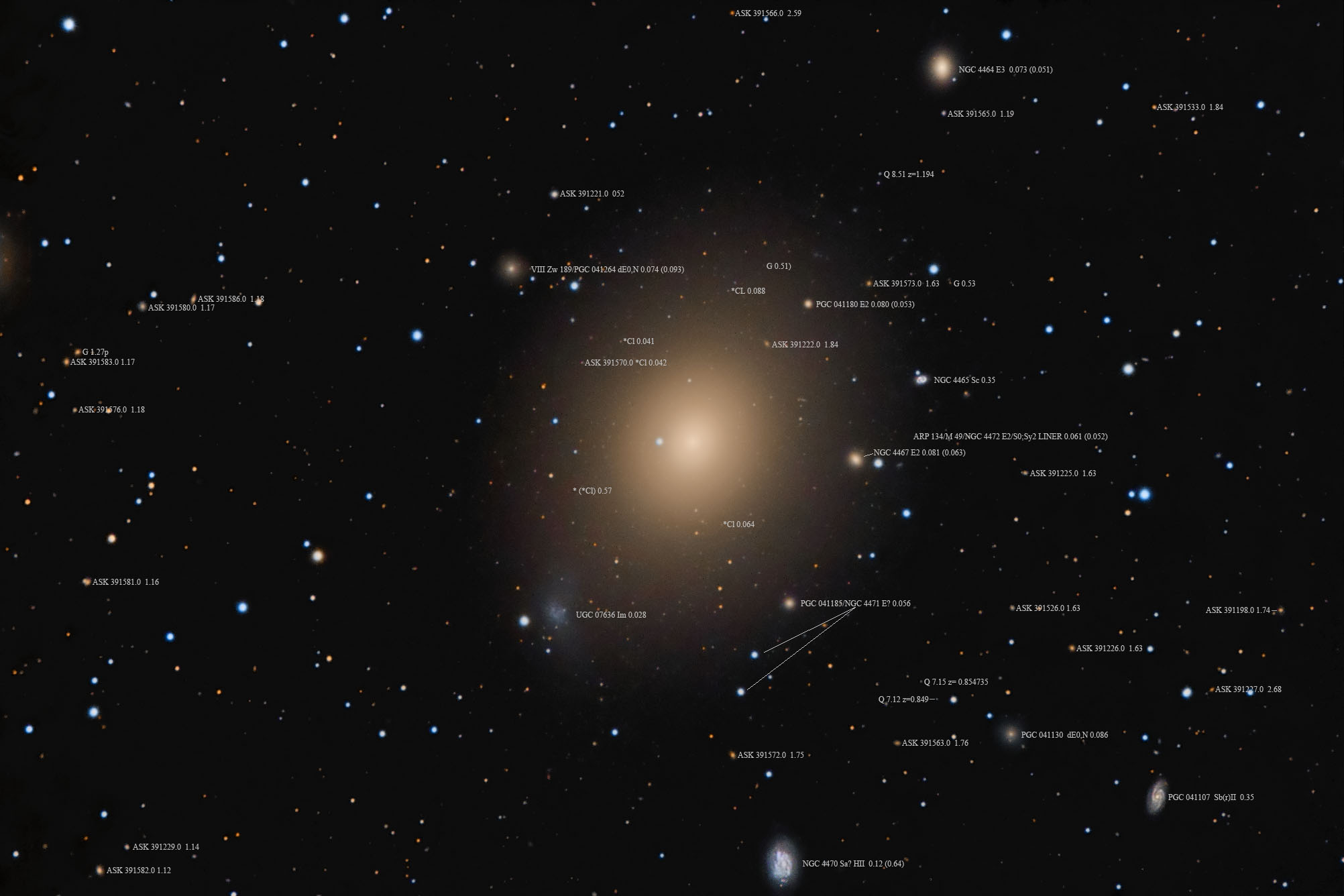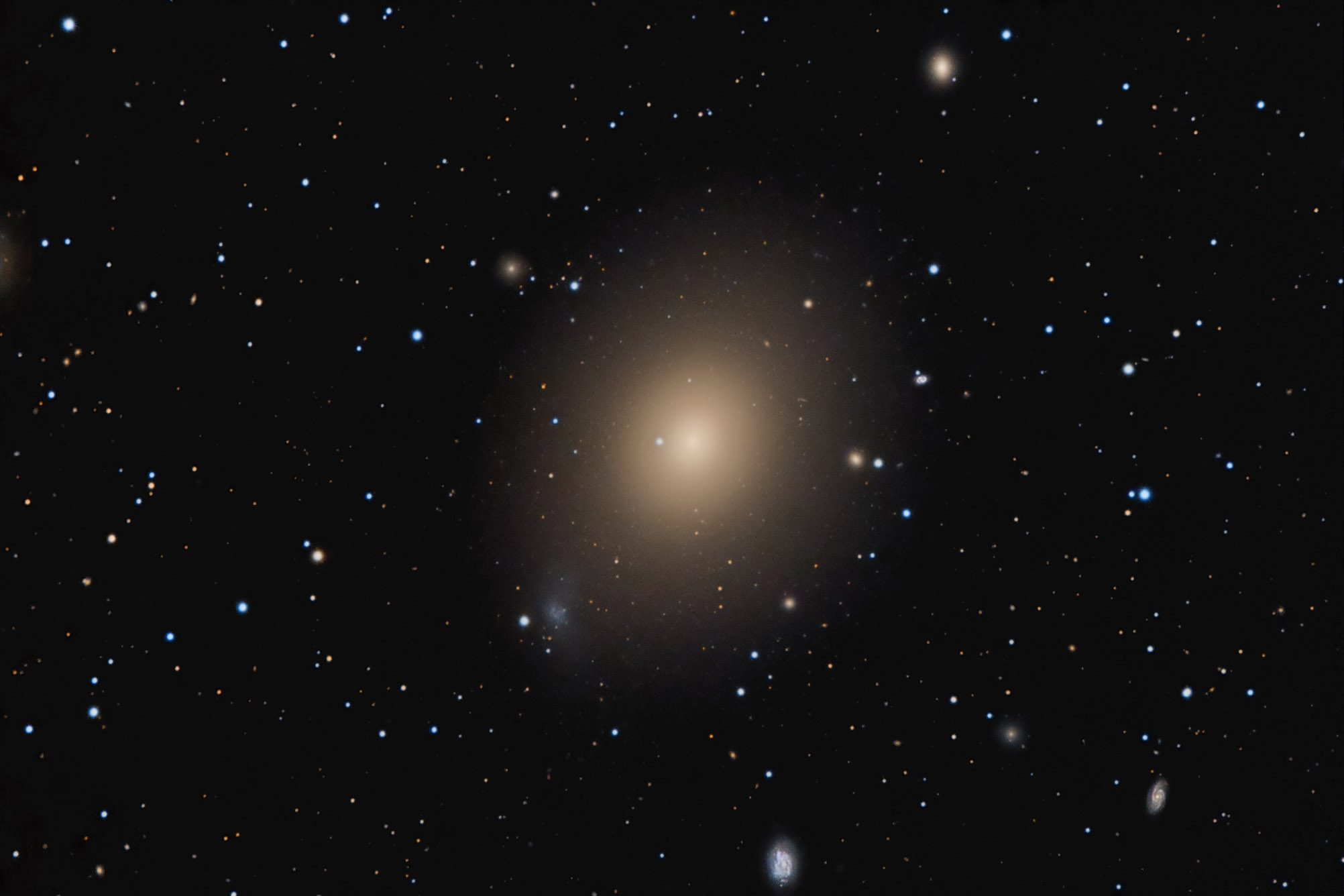| Description | Images |
Object name: ARP134Designation(s): ARP134, M049, NGC4464, NGC4465, NGC4467, NGC4471, NGC4472, NGC4470, UGC07636, Arp 134 is a galaxy very familiar to amateur astronomers being it is one of the biggest and brightest galaxies in the sky and looks perfectly normal to the eye and in most photos. I'm talking about the giant elliptical galaxy M49. So why would a perfectly normal elliptical make the list? Seems it is eating its companion UGC 07636. It is in Arp's classification as "Elliptical or elliptical-like galaxies; with nearby fragments", Arp had no comment on this one. UGC 07636 is the "fragment." Apparently, he thought it part of M49 rather than an appetizer as he didn't give it an identification and most Arp lists don't include it as part of Arp 134 even though it is. In my shot, it is the blue splat like feature on the "front" of M49. Looks to me like where a blue phaser is hitting the Enterprise's shields and the energy is being spread across the shields. Notice the blue stars ripped from the galaxy spreading into M 49 or at least appearing to do so. In a black and white photo like you normally see this contrast is lost. M49 was first recorded by Charles Messier on February 19, 1771. Related Designation(s):1ES 1227+082, 1H 1228+081, 1RXS J122931.5+080001, 1RXS J122945.9+075927, 2MASS J12292131+0809238, 2MASS J12292354+0801333, 2MASS J12293026+0759340, 2MASS J12293706+0755578, 2MASS J12293781+0749265, 2MASS J12294675+0800019, 2MASX J12292131+0809236, 2MASX J12292353+0801336, 2MASX J12293026+0759346, 2MASX J12293706+0755576, 2MASX J12293780+0749266, 2MASX J12294679+0800014, 2XMM J122921.2+080922, 2XMM J122930.3+075934, 2XMM J122937.8+074931, 2XMM J122946.8+080003, 2XMMp J122921.2+080921, 2XMMp J122937.7+074931, 2XMMp J122946.7+080003, 87GB 122714.6+081649, 87GB[BWE91] 1227+0816, ACSVCS 001, ACSVCS 046, ACSVCS 079, AKARI J1229375+074934, ALFALFA 3-284, ARK 369, ARP 134, ARP134, ASK 391564.0, ASK 391568.0, ASK 391569.0, CALIFA 548, CGCG 042-127, CGCG 042-128, CGCG 042-130, CGCG 042-132, CGCG 042-134, CGCG 042-135, CGCG 1226.8+0818, CGCG 1226.8+0826, CGCG 1226.9+0816, CGCG 1227.0+0806, CGCG 1227.2+0816, CGCG 1227.5+0812, CXO J122921.3+080922, CXO J122921.30+080923.8, CXO J122930.20+075934.4, CXO J122930.3+075933, CXOU J122930.2+075934, ECO 03596, EVCC 0722, EVCC 0742, EVCC 0743, EVCC 0755, EVCC 0766, EVCC 2134, FAUST 3177, FAUST 3181, FAUST V081, FAUST V083, GALEX J122946.6+080000, GALEX J122946.7+080006, GALEXASC J122921.34+080923.6 , GALEXASC J122930.28+075934.5 , GALEXASC J122937.16+075558.1 , GALEXMSC J122921.31+080923.9 , GIN 781, GR 06, HDCE 0720 NED115, HDCE 0720 NED118, HDCE 0720 NED120, HDCE 0720 NED121, HIPASS J1229+07, HOLM 413A, HOLM 413C, HOLM 413D, IRAS 12270+0806, IRAS F12270+0806, LDCE 0904 NED140, LDCE 0904 NED143, LDCE 0904 NED145, LDCE 0904 NED146, LGG 288:[G93] 009, LGG 289:[G93] 034, LGG 289:[G93] 078, LGG 292:[G93] 015, LQAC 187+008 003, M049, MCG +01-32-078, MCG +01-32-080, MCG +01-32-082, MCG +01-32-083, MCG +01-32-084, MESSIER 049, MG1 J122942+0800, NGC 4464, NGC 4464:[L2011a] X0001, NGC 4465, NGC 4467, NGC 4467:[L2011a] X0001, NGC 4470, NGC 4471, NGC 4472, NGC 4472 DW07, NGC 4472:[L2011a] X0041, NGC 4472:[LB2005] X01, NGC 4610, NGC4464, NGC4465, NGC4467, NGC4470, NGC4471, NGC4472, NSA 141486, NSA 161886, NVSS J122946+080002, PGC 041148, PGC 041157, PGC 041169, PGC 041185, PGC 041189, PGC 041220, PGC 041258, PRC D-21, RBS 1118, RGB J1229+080, RX J1229.7+0759, RX J1229.7+0759:[BEV98] 001, RX J1229.7+0759:[ZEH2003] 01 , RXC J1229.7+0759, SDSS J122921.29+080923.8, SDSS J122923.53+080133.4, SDSS J122923.70+080135.7, SDSS J122930.24+075934.2, SDSS J122930.24+075934.3, SDSS J122930.25+075934.3, SDSS J122937.05+075557.8, SDSS J122937.05+075557.9, SDSS J122937.77+074927.1, SDSS J122937.78+074927.1, SDSS J122946.76+080001.7, SSTSL2 J122921.27+080924.5, UGC 07619, UGC 07627, UGC 07629, UGC 07636, UGC07636, USGC U489 NED01, USGC U490 NED173, USGC U490 NED177, USGC U490 NED180, USGC U490 NED186, UZC J122921.3+080923, UZC J122923.5+080134, UZC J122930.2+075934, UZC J122937.9+074926, UZC J122946.6+075958, UZC J123000.7+075544, VCC 1178, VCC 1182, VCC 1192, VCC 1203, VCC 1205, VCC 1226, VCC 1249, WBL 410-001, WBL 410-002, WBL 410-003, WBL 410-004, WBL 410-005, WBL 410-006, XSS J12312+0833, [AHG2014] B182, [BEC2010] HRS 177, [BEC2010] HRS 178, [CHP2004] J122930.2+075934, [FCJ2006] 001, [FCJ2006] 046, [FCJ2006] 079, [KK98] 122728.2+081224, [KK98] 150, [M98j] 174 NED122, [M98j] 174 NED127, [M98j] 174 NED128, [MB2007] J187.4249+08.0055, [PJC2008] 001, [PJC2008] 046, [PJC2008] 079, [R83] 08deg033, [TTL2012] 575405, [VCV2006] J122946.8+080002, [WB92] 1227+0816, |

